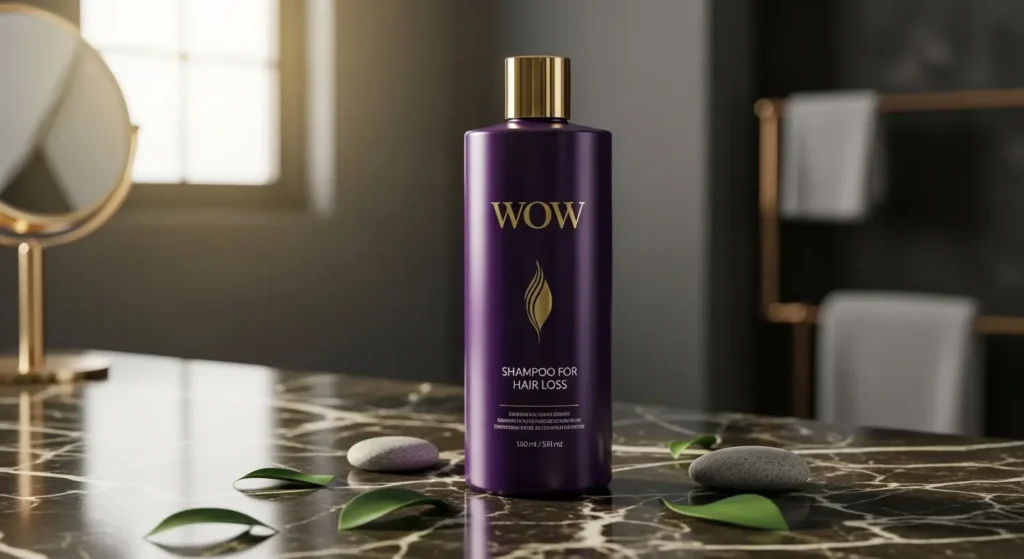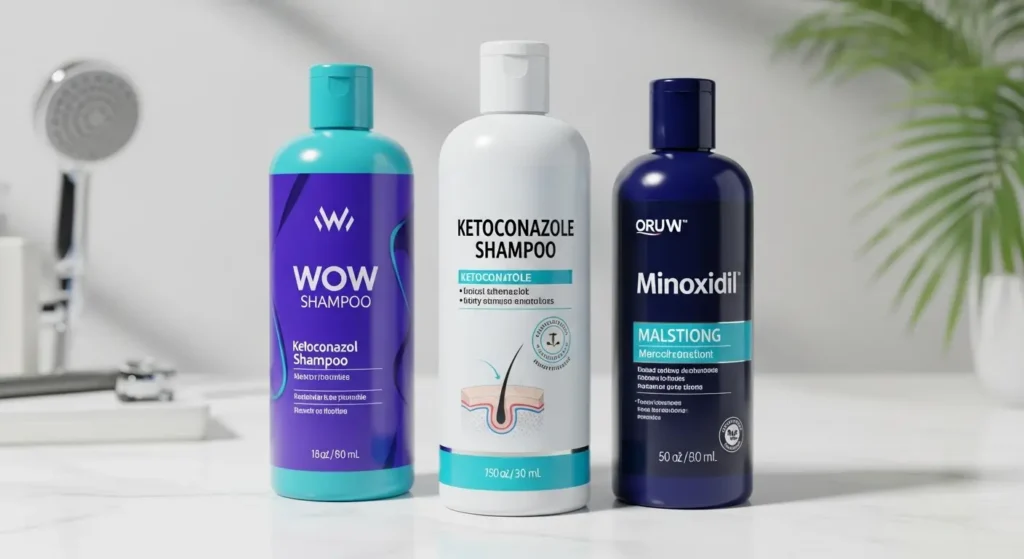Struggling with thinning hair or excess shedding? WOW shampoo for hair loss has gained popularity for its plant-based formula and bold claims, but can it truly help?
In this guide, we’ll break down its ingredients, share real user experiences, and compare it with proven alternatives.
You’ll discover how to use it effectively, what results to expect, and when to consult a specialist. Backed by expert insights, this article helps you make an informed and confident choice for your hair health.

Understanding the “WOW Shampoo” Phenomenon
What is WOW Shampoo?
WOW is a brand known for its natural, sulfate-free, and paraben-free shampoos. Popular variants include:
- Apple Cider Vinegar (ACV) Shampoo – marketed for scalp detox and dandruff control.
- Onion Black Seed Shampoo – promoted for strengthening roots.
- Coconut Milk Shampoo – targeted at hydration and frizz control.
These shampoos are vegan, cruelty-free, and heavily marketed on Amazon, Instagram, and wellness blogs as solutions for hair fall and thinning.
Why People Try It for Hair Loss and Thinning
Many turn to WOW shampoo because:
- They want chemical-free alternatives.
- They believe natural ingredients like apple cider vinegar or onion oil may stimulate hair growth.
- They are experiencing mild hair fall and looking for an easy, over-the-counter solution.
- WOW Shampoo for Hair Loss
Top Ingredients and Their Roles
- Apple Cider Vinegar – helps balance scalp pH, reduce buildup, and create a healthier scalp environment.
- Onion Black Seed Oil – traditionally believed to improve circulation to follicles.
- Biotin – often added in formulations, though topical absorption is limited.
- Coconut Extracts – moisturize and reduce breakage.
Benefits & Limitations
Potential Benefits
- Sulfate- and paraben-free (gentle on scalp).
- Plant-based actives like ACV and onion oil may improve scalp circulation.
- Helps detox scalp buildup, which can reduce minor shedding.
- Vegan and cruelty-free, appealing to eco-conscious buyers.
Common Limitations
- Results vary widely between users.
- No clinical evidence that WOW shampoo regrows hair.
- Some report increased dryness or hairfall.
- Works best as a supportive scalp cleanser, not as a treatment for severe hair loss.
Variations in Results
Marketing promises can create unrealistic expectations. Users with mild shedding may see some benefit, while those with hormonal or genetic hair loss are unlikely to notice major changes without medical treatments like minoxidil or finasteride.
How to Use WOW Shampoo Best for Hair Loss
Recommended Usage Frequency
- Use 2–3 times per week.
- Apply to wet hair, massage gently into the scalp, and rinse thoroughly.
- Many dermatologists recommend diluting WOW shampoo with water to minimize irritation.
Pairing with Other Treatments
For better results, combine with:
- Topical minoxidil (clinically proven for regrowth).
- PRP therapy for advanced thinning.
- Scalp massage to improve blood circulation.

Scalp Health Practices
- Avoid overwashing, which strips natural oils.
- Use a conditioner after shampooing to prevent dryness.
- Maintain a balanced diet with protein, iron, and vitamins.
What People Are Saying
Positive Feedback
- Reduced dandruff and itching.
- Hair feels cleaner and lighter after wash.
- Eco-friendly packaging and cruelty-free branding appreciated.
Reports of Hairfall & Misuse
- Some users report increased shedding, often due to overuse or using undiluted shampoo.
- Dryness and tangling noted in fine or curly hair types.
Third-Party Review Aggregations
Independent platforms like Zoobop rate WOW shampoo as moderately safe but not highly effective for hair regrowth, highlighting its clean-label marketing but limited clinical backing.
Expert & Scientific Evaluation
Ingredient Efficacy Overview
- Apple Cider Vinegar: Good for scalp health, not hair regrowth.
- Onion Oil: Some small studies suggest benefit, but evidence is weak.
- Biotin in shampoo: Minimal absorption through scalp; oral supplements may be more effective.
Scientifically Supported Alternatives
- Ketoconazole shampoo – proven to reduce dandruff and mild androgenetic alopecia symptoms.
- Caffeine shampoos – some evidence for stimulating follicles.
- Prescription treatments – minoxidil and finasteride remain gold standards.
When to Consult a Dermatologist
If you notice:
- Sudden patchy bald spots.
- Continuous shedding despite lifestyle changes.
- Signs of scalp infection or inflammation.
Seek professional guidance instead of relying on over-the-counter shampoos alone.
Comparison Chart:
| Product | Evidence for Hair Loss | Best Use Case |
|---|---|---|
| WOW Shampoo | Low | Scalp detox, mild shedding |
| Ketoconazole Shampoo | Moderate | Dandruff + hair thinning |
| Minoxidil | Strong | Genetic hair loss treatment |

FAQs
Can WOW Shampoo regrow hair?
No WOW shampoo can improve scalp cleanliness and reduce buildup but does not regrow hair.
Is it safe for colored hair?
Yes, since it’s sulfate-free, it is generally safe for chemically treated hair.
How often should one use it, and should it be diluted?
2–3 times per week, ideally diluted with water to reduce irritation.
What if I experience irritation or increased shedding?
Stop use immediately and consult a dermatologist to rule out underlying scalp conditions.
Next Step
If you’re concerned about hair loss, remember that shampoos alone rarely provide lasting solutions. WOW shampoo may support scalp health, but professional treatments are often necessary for real regrowth.
Book a consultation with Dr. Rana Irfan in Islamabad today to get a personalized diagnosis and advanced treatment plan tailored to your needs.
